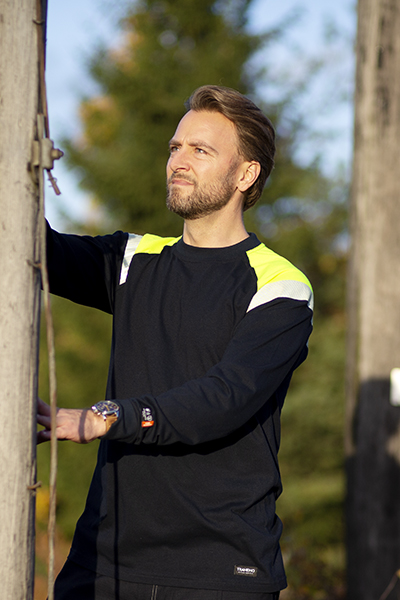
SUSTAINABLE MATERIALS & TECHNOLOGIES
Our aim is to minimise environmental and climate impact throughout the life of the product until a garment is worn out and ready for recycling. Therefore, we focus on integration of more sustainable materials and technologies to reduce the climate impact.
There is a need for new approaches in the development of materials and new types of environmentally friendly technologies that meet current expectations of sustainable products. Use of more sustainable fibers and materials are prerequisites for creating environmental benefits.
RECYCLED FIBRES
There are many factors to take into account when you assess the overall environmental impact of a garment. We see a good potential in using recycled fibres in our garments, as long as it doesn’t affect long-term product durability.
Recycled cotton
Recycling cotton fibre has significant benefits in tackling issues that are specific to cotton cultivation - such as the release of toxins into soil and water which lead to over-fertilisation and subsequent toxic effects on the environment. By using recycled cotton in our garments, we reduce the amount of new cotton that has to be grown. And by using cotton that is already in circulation, we reduce the strain on nature’s resources. A certain amount of new cotton is still needed to ensure that the fabric remains strong and its strength is not compromised. Tranemo therefore uses a mix of virgin and recycled cotton fibres.
Recycled polyester
In 2021 we have introduced recycled polyester in our quilted winter garments in our non- flame retardant garments. The quilt contains about 45% recycled fibres, depending on the construction. Recycled polyester is made from post-consumer PET, and is certified recycled.
SOLUTION DYEING
We strive to apply solution dyeing for the products that are suitable for this dyeing technique. Traditional dyeing requires a two-step process. In the first step, fibres are produced without colouring. In the second step, colour is applied to the fibre. With solution dyeing, one step is eliminated. It is based on a process of adding pigments to the spinning solution. The solution dyeing technology significantly reduces water use in the dyeing process and reduces energy use and subsequent greenhouse gas emissions.
Replacing synthetic piece dyed fabrics with solution dyed fabrics, can result in a reduction of 16% in total climate impact.
Positive environmental effects of solution dyeing:
- Helps to reduce water consumption during production
- Helps to reduce the chemical pollution of our planet
- Helps to reduce CO2 emissions
PRE CONSUMER WASTE
Our aim is to move towards a circular economy by reducing waste and minimizing the production of new materials. To achieve this, we return production waste to our weavers who use the recycled pre-consumer waste to create new high-quality fabrics. Our fabric 932 contains 20% pre-consumer Tera TX material and, in addition, it is PFAS-Free. To maintain the fabric's strength and durability the recycled fibers are located on the backside of the fabric towards the laminate. We are looking forward to keep working towards a truly circular economy where we close the loop, re-integrating our own waste into new materials within our company.

